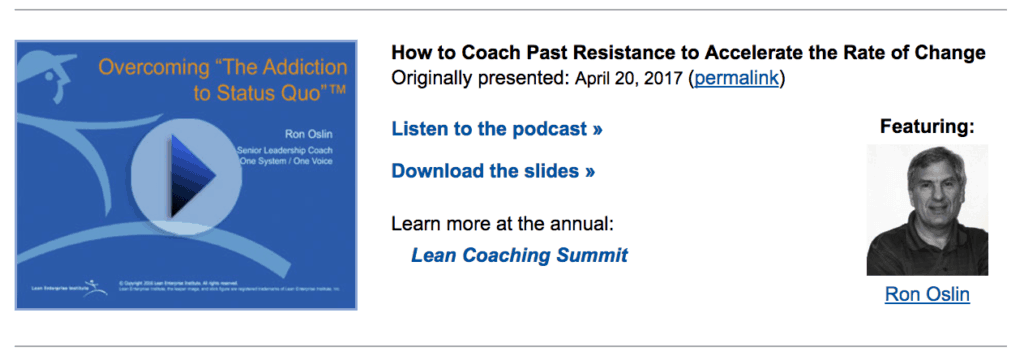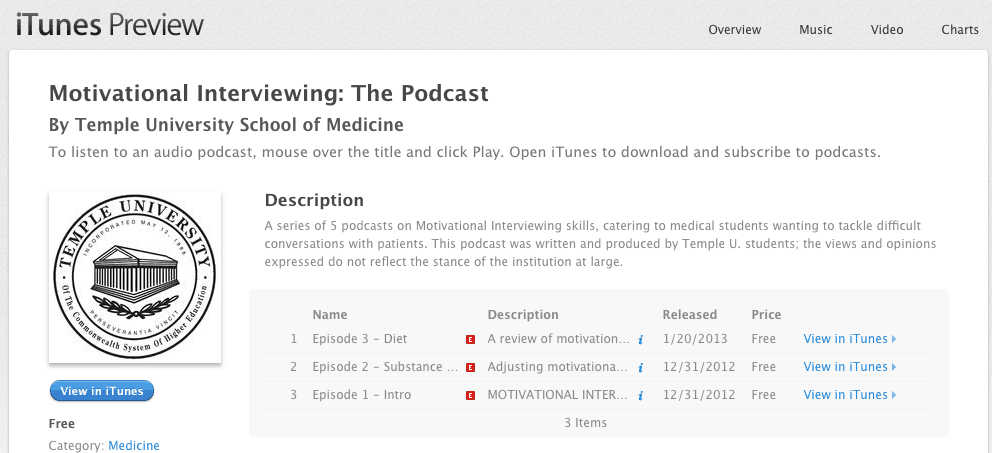Hear Mark read the post (subscribe to the podcast)
I'm excited to be attending the annual Lean Coaching Summit today through Thursday in Austin. If you're there, please say hi!
While I've presented at past events organized by Lean Frontiers (and this Summit is co-organized by my former employer, the Lean Enterprise Institute), this year, I'm attending to learn, to connect with familiar faces, and to meet new people.
Today, I've registered to take a class on a topic that I've taken an interest in over the past few years: “Motivational Interviewing,” or MI for short.
Update: I've edited this post a bit to clarify my understanding based on what I learned in the class. The audio podcast recording reflects those changes.
I'm taking this class, taught by former Toyota employee Ron Oslin:
Coaching Those Who Are Not On Board, In Denial or “Addicted to the Status Quo” and Actively or Passively Resisting Change
You can read this article that he linked to in the class description:
Please review this article describing the “Addiction to Status Quo” and the pitfalls of coaching those “Addiction to Status Quo”.
As I've blogged about before, it's not helpful to complain about people who are “resistant to change.” We need to work together with them, as leaders or coaches. That's what MI is about, from a clinical addiction counseling standpoint, and it applies to the workplace. MI isn't about telling people what to do… it's about helping them articulate why they should change, their commitment to changing, and how they are going to change.
Here is a webinar that Ron did recently for LEI on the topic of connecting MI to the workplace (seems to not be available online now).

And here's a video of him giving a keynote talk (no longer available).
Here's an article he wrote for LEI on this topic.
I'm excited to learn more about how to apply this method to my Lean coaching. Now, it's unlikely that anybody is going to come to me and say they are “addicted” to old leadership behaviors and habits.
But, I believe strongly in the MI notion that Ron talks about in that video — nobody can force anybody else to change. That's true when it comes to a change like quitting smoking and it's true when it comes to embracing Lean or Kaizen.
Change Talk
When I talk with people, I hear various degrees of what MI calls “change talk.”
As described here, the types of change talk include:
- Desire: Why would you want to make this change?
- Ability: How would you do it if you decided?
- Reason: What are the three best reasons?
- Need: How important is it? and why?
- Commitment: What do you think you'll do?
Another way of describing it (via this PDF):
- Desire: A wanting, wishing or willing. They do not express specific reasons, but express a general level of desire.
- Ability: Personal perceptions of capability or possibility of change. Generally express a level of ability.
- Reasons: Specifies a particular rationale, basis, incentive, justification, or motivation for making the target behavior change.
- Need: Necessity, urgency, or requirement (for change). Usually, these statements do not include specific reasons, but express general level of need.
- Commitment: Agreement, intention or obligation to future target behavior change.
- Action: Current movement toward change.
- Taking Steps Toward Change: Describe a particular action that the person has done in the recent past that is clearly linked to moving toward the target change.
DARNCAT is an mnemonic that's easy to remember. Or DARN-C for the 5-point version.
What follows are some of my attempts to think through this… as a reader, keep in mind I'm far from an expert in the MI approach… I'm a beginner who has read the core text book (Motivational Interviewing: Helping People Change, 3rd Edition) and has written a few blog posts with thoughts and reflections.
Anyway, some thoughts on change talk…
Desire
An example of a desire statement in the context of Lean might be:
“I wish we could engage everybody in problem solving and continuous improvement.”
That seems more like a hope than a plan. “I wish we could be Lean.” How likely is it for somebody to follow up on a hope and a dream? As a coach, we have to empathetically draw more out of them through guided discussion.
We should, though, be happy to hear desire statements because they are, at least, a form of change talk and that's positive.
Ability
For any change, we need more than desire… we need some semblance of ability. “I'd love to be able to speak Japanese” might be another desire statement.
I might, personally, feel very unconfident in my ability to learn or to make time for such a thing, so I might not take any steps.
A good coach would ask about your perceived ability to do this… and we might have a similar discussion in the context of Kaizen (adapted from this page):
Client: “It would be great if everybody was engaged in continuous improvement.”
Coach: “I know you might not be ready to start, but if you were, what are some things you might do?”
Client: “It would be really hard, but I could stop going to that daily 10 am bed board meeting where I don't really help make any decisions. I could use that time to round on my staff.”
Coach: “While it might be hard, it sounds like using that hour each day would be a good start.”
I love how MI focuses on NOT giving answers (a theme similar to a lot of the discussion in the Lean coaching realm). When you give somebody an answer, they might very well get defensive. Imagine this exchange and what the results might be:
Client: “It would be great if everybody was engaged in continuous improvement.”
Coach: “Well, you need to get out of your office and get to the gemba more, that would be a good start. Isn't that 10 am bed board meeting a waste of time for you anyway?”
Client: “But my VP expects that I'm going to be at that meeting. I know I don't contribute every day, but the day I stop going is the day my input will be needed. This bed board meeting is too important… I need to keep going.”
Defensiveness leads to people digging in their heels and not taking steps forward. Ironically, telling people they need to change makes it less likely that they will change.
Reason
A reason statement seems to be a stronger predictor of change. It's like the Lean idea of “starting with why?” What are you hoping to accomplish?
Coach: Can you give me three good reasons why you might consider engaging everybody in improvement?
Client: Hmmm… the act of engaging people will probably increase our engagement scores, which is on my performance plan. And, it seems like we should tap into everybody's ideas so we can solve more problems and boost outcomes and HCAHPS scores… our hospital really depends on payments that come from good scores. I think more engaged employees will be happier and less likely to quit and leave… I guess there are a lot of reasons.
Coach: It seems that you and the hospital would be more successful if you're able to engage more people in improvement.
The coach here is giving “reflections” — not just parroting back what was said, but making supportive statements that reflect back what's being said and the attitude behind the statements. We want to encourage more change talk.
Now, the focus is less on “you need to do Kaizen” and more about Kaizen being a means to the ends that matter and the measures that are already in place.
Need
Now, we can probably all think of situations where there are many good LOGICAL reasons to change… but we still don't. Do we want to change (a desire?) or do we need to change because the consequences of not changing are unbearable?
Now, this might not be the continuation of the above dialogue…
Coach: How important would you say engaging everybody in Kaizen is right now?
Client: Not very.
Coach: Why do you say that?
Client: I have so many other things on my plate… big initiatives, reorganization, a potential merger… it just doesn't seem like the right time.
Coach: It seems to you that engaging everyone in improvement is not the most important thing right now. What would have to happen to make it more important?
Client: I think if I had a clear objective and mandate on my plan for the new fiscal year, that might get my attention.
Now, a need like that might not be the most high minded (the client should want to engage people for the right reasons), there are certain realities (the goals on the annual plan) and we need to meet people where they are and get progress rather than triggering defensiveness and excuses. Remember, we're trying to draw out THEIR reasons for change, not impose ours.
Commitment
It's great when you hear (or can draw out) statements of commitment. We've shifted from wishing we could to taking concrete steps and actions.
Coach: What do you think you'll do about engaging your team in improvement? What ideas do you have for yourself?
Client: I'm not sure. I could stop giving people answers in our daily huddles. People are so used to me telling them what to do. I'll start tomorrow by asking more questions and asking them what they think… like you've been doing with me right now.
What Change Talk Do You Hear?
As you go through the day, be attuned to what language you hear. See if you can categorize the things you hear… and what do you think about these statements from work and life outside of work?
- We really need to get those patient satisfaction scores up
- I wish we had more time for Lean and 5S follow up
- I need to lose 10 pounds so I can fit better into those new suits I bought last year
- I'm going to put 30 minutes on my calendar for a gemba walk each morning, starting tomorrow
- If we engage people in improvement, I bet our staff turnover will go down
- I'd like to write a book some day
- I'm ready to start rounding on employees
- If my cholesterol was lower, I'd be a lot healthier
- I swear, I'll be better about asking staff for ideas
- I'm going to start traveling with running shoes so I can work out more on the road
- I can be better about not blaming people
I also recently found this podcast series to be useful, which talked about Desire, Reason, Need, and Commitment, while also talking about the need to ask the client about their ability (or perceived ability):

Please scroll down (or click) to post a comment. Connect with me on LinkedIn.
Let’s work together to build a culture of continuous improvement and psychological safety. If you're a leader looking to create lasting change—not just projects—I help organizations:
- Engage people at all levels in sustainable improvement
- Shift from fear of mistakes to learning from them
- Apply Lean thinking in practical, people-centered ways
Interested in coaching or a keynote talk? Let’s start a conversation.




![When Was the Last Time a Leader Around You Admitted They Were Wrong? [Poll]](https://www.leanblog.org/wp-content/uploads/2025/07/Lean-Blog-Post-Cover-Image-2025-07-01T212509.843-238x178.jpg)



![When Was the Last Time a Leader Around You Admitted They Were Wrong? [Poll]](https://www.leanblog.org/wp-content/uploads/2025/07/Lean-Blog-Post-Cover-Image-2025-07-01T212509.843-100x75.jpg)

I learned there is a book on MI applied to the workplace:
Motivational Interviewing for Leadership: MI-LEAD
I can’t wait to check it out.
Lesson from the workshop:
Any of that change talk opens the door to the possibility of change. We’re looking for problem recognition, talk of the benefits of change, talk about the intent for change and then optimism for change… a willingness and intention to change.
As helpers, we need to evoke as much change talk as possible (as opposed to talk about maintaining the status quo). We’re looking for indicators that they are receptive to change.
I found the examples of MI to be very helpful. A coach can serve as a auxiliary conscience when listening for motivation, stage of change, and change talk.